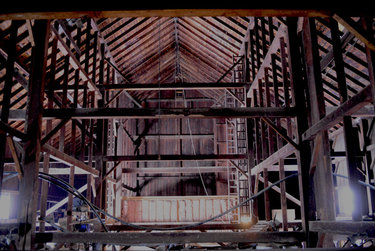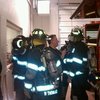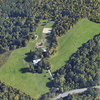Board members share visions for new year
— Photo by Dietrich Gehring
“Awe-inspiring” is how New Scotland Councilman Daniel Mackay described the LeVie barn, once the site of a popular farm stand on Route 85A, and now slated for demolition because of the Kensington Woods development. Mackay, when listing his goals for 2014 at the town’s reorganizational meeting, said he’d like to save the 115-year-old structure “in some way, shape, or form.”
The Enterprise — Melissa Hale-Spencer
Raising their right hands, from left, New Scotland Councilman Douglas LaGrange, Supervisor Thomas Dolin, Councilman Daniel Mackay, and Highway Superintendent Kenneth Guyer take the oath of office administered by Clerk Diane Deschenes. The board held its re-organizational meeting on Jan. 2 in the midst of a snowstorm.
The Enterprise — Melissa Hale-Spencer
Edie Abrams smiles after commending the New Scotland Town board on its work and asking for an “inkling” of what the new year may hold. Behind her is her husband, Saul Abrams. They were among a handful of residents attending the brief re-organizational meeting on Jan. 2.
NEW SCOTLAND — Encouraged by a citizen activist, town leaders shared their visions for the new year at last Thursday’s re-organizational meeting.
The session, held in the midst of a snowstorm, lasted just half an hour as an uncontested election in November kept the incumbents in their posts.
The Republicans put up no candidates following a controversy around the intersection of routes 85 and 85A, which had been zoned for commercial development, although only ever used for agriculture, when, in 2008, interest arose in building a Target-anchored mall there. After two previous failed attempts, and two election cycles, the town board in 2012 passed a law limiting the size of large-scale development at the intersection.
Towards the close of the Jan. 2 meeting — after Supervisor Thomas Dolin, Councilmen Douglas LaGrange and Daniel Mackay, and Highway Superintendent Kenneth Guyer had been sworn in for new terms, and after a series of unanimous appointments — Edith Abrams stood in the gallery to commend the board members on their work.
“The town has quieted,” said Abrams, who was active in the citizens’ group that had protested big-box development. “Residents are satisfied,” she said.
She commended the board on making the government “more professional,” listing such accomplishments as developing an ethics code and defining jobs.
“You’ve done away with the old-boy network,” said Abrams.
Then she asked to hear the board’s plans for the coming year.
“That’s a tall order,” responded Dolin.
Not to be dissuaded, Abrams replied, “Just an inkling.”
LaGrange said, first and foremost, he’d like to tie up loose ends on the whole size-cap issue.
“Hopefully, finish our FEMA projects,” said Dolin, referring to repairs being made after Tropical Storm Irene ravaged the area in 2011, resulting in funds coming in from the state and the Federal Emergency Management Agency; Dolin said repairs should be completed this year.
Dolin went on to say that, by November of this year, 170 families are scheduled to get municipal water in the New Salem District.
“Wow,” responded Abrams.
The New Salem project was nearly a decade in the making, after New Scotland and the neighboring town of Bethlehem came to an agreement to install new lines; Bethlehem’s reservoir is located in New Scotland.
Because of the improving economy, Dolin said, New Scotland has had “a raft of inquiries and applications for new residential subdivisions.”
He noted, “They’ll need a source of water,” and said, “The board and town officers will have to try and solve these problems.”
Next spring, said Dolin, work will start on the infrastructure for the 170-house Kensington Woods development. That development will have its own water source and possible treatment center.
Councilman William Hennessy, for his part, said the board this year will continue to pursue an addition or renovations to the town’s highway garage.
He also said that establishing an economic development advisory committee is a priority. This would incorporate all of the town’s hamlets and perhaps the village of Voorheesville as well, he said.
“Everything on the table will take the cooperation of the full board,” said Mackay. “We’ve assembled a very effective team,” he said, and the board will continue to invite members of the public to serve on committees.
Mackay listed several priorities. One is to work on emergency services, he said noting the “challenge of working with the village.”
The town currently contributes 61 percent of the budget for the Voorheesville Area Ambulance Service while the village pays the remaining 39 percent. Throughout 2013, Voorheesville had publicly battled with the squad whose leaders said they would prefer to work exclusively with the town although recently both the VAAS and the village say they are working towards a new contract.
Second, Mackay said the board needs to make revisions to New Scotland’s comprehensive plan to “make sure it syncs” with the 85 – 85A corridor.
Third, he spoke of the “impending wave” of AC and DC transmission lines that could run through the town and the need “to see what mitigation” might be used.
Finally, Mackay talked of the need to continue to advocate for such things as maintaining open space, developing trails, and preserving historic barns. He mentioned, in particular, the LeVie barn, on Route 85A, that is slated for demolition because of the Kensington Woods development. He spoke of a “strong interest in saving that in some way, shape, or form.”
Mackay told The Enterprise that he had recently visited the 115-year-old barn, describing its massive size and cathedral-like qualities. “It was awe-inspiring, the size and the workmanship,” he said.
Appointments
By unanimous vote, and without discussion, the board made these appointments:
—Jeff Baker for a one-year term as counsel to the planning and zoning boards;
— Charles Voss for a year as chairman of the planning board;
— Thomas Hart as a planning board member through Dec. 31, 2018;
— Adam Greenberg for a year as chairman of the zoning board;
— Edith Abrams as a zoning board member until Dec. 31, 2018;
— Douglas Miller as a constable for a one-year term;
— Ronald Bates as a constable for a one-year term;
— Douglas Miller as public safety commissioner for a year;
— Kenneth Guyer as deputy public safety commissioner for a year;
— Lyon M. Greenberg, M.D. as chairman of the ethics board, without pay, for a year;
— Charles Voss, as a member of the ethics board, without pay, until Dec. 31, 2016;
— Kevin Schenmeyer as dog warden captain and James Conde as dog warden, each for a year;
— Jeremy Cramer as building department head, part-time building inspector, and deputy code-enforcement officer;
— Jeffry Pine as assistant building inspector and code-enforcement officer;
— Patricia Barber as town registrar;
— Jeremy Cramer as town constable, without pay;
— J. Michael Naughton as town attorney until Dec. 31, 2015;
— The Altamont Enterprise as the official newspaper; and
— First Niagara the depository for funds with Key Bank, citizens’ Bank, Pioneer Bank, and M&T Bank as alternates.
Salaries
The board also set, by unanimous vote, these salaries:
— $8,093.44 annually for each of the four council members;
— $26,112.75 annually for each of the two town justices;
— $18.36 hourly for each of the court clerks;
— $20.40 hourly for each of the two constables;
— $57,830.55 annually for the supervisor;
— $21.94 hourly for the supervisor’s clerk and the conference secretary;
— $16 hourly for the part-time clerk 1;
— $32,643.20 annually for the assessor;
— $19.13 hourly for the assessment clerk;
— $1,343.77 annually for the chair of the board of assessment review;
— $671.16 annually for the other four members of the board of assessment review;
— $54,104.88 annually for the town clerk;
— $21.94 hourly for the deputy town clerk;
— $15.93 hourly for the part-time clerk 1;
— $42,844.20 annually for the town attorney;
— $188.71 hourly for the part-time attorney;
— $25.25 for the director of public works;
— $106.12 hourly for the internal control officer;
— $11.22 hourly for the part-time janitor and laborer;
— $9,982.95 annually for the dog warden captain;
— $9,464.43 annually for the dog warden;
— $1,212 annually for the public safety officer;
— $68,680 annually for the highway superintendent;
— $18.36 hourly for the part-time highway clerk 1;
— $17.34 hourly for the senior citizen coordinator;
— $20.40 hourly for the park and building maintenance worker
— $18,000 annually for a seasonal parks worker;
— $2,700 annually for a camp director;
— $2,250 annually for two camp assistants;
— $700 annually for a drama camp instructor and a baseball instructor;
— $1,900 annually for a basketball instructor;
—$1,000 annually for a sports instructor;
— $560 annually for a lacrosse instructor;
— $1,250 annually for a flag-football instructor;
— $500 annually for a music instructor;
— $600 annually for a golf instructor;
—$525 annually for a tennis instructor;
— $16.84 hourly for a transfer station worker;
— $14.28 hourly for a transfer station worker;
— $47,924.50 annually for the deputy code enforcer/building inspector and an additional $1,020.10 annually for his stormwater;
— $42,234.06 annually for the code enforcement officer plus an additional $3,060.30 for his stormwater work
— $15.81 hourly for an inspection clerk 1;
— $1,836.18 annually for a registrar;
— $3,837.48 annually for the chairman of the zoning board;
— $1,919.16 annually for the four other members of the zoning board;
— $4,377.76 annually for the chairman of the planning board;
— $2,188.89 annually for the four other members of the planning board;
— $13,091.40 annually for the assistant town attorney;
— $15/53 hourly for the board clerk;
— Hourly salaries ranging from $19.19 to $22,96 for 12 highway workers;
— $22.96 hourly for an auto mechanic foreman; and
— $22.47 hourly for a water and sewer equipment operator.



